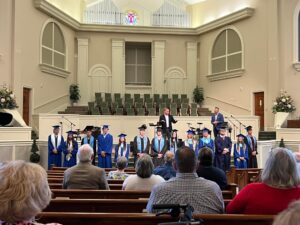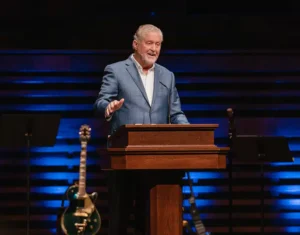
EDITOR’S NOTE: This story first appeared in The Christian Index, newsjournal of the Georgia Baptist Convention.
ALPHARETTA, Ga. (BP)–When Georgia Baptists gather in Phoenix for the annual meeting of the Southern Baptist Convention, they will hear from two new agency heads for the first time.
Tom Elliff has announced he will “newly introduce” the International Mission Board to a new generation of young pastors and churches who may not be familiar with the agency. But the North American Mission Board may get the most attention as its new president rolls out his vision for a leaner, more focused agency that has experienced a top-to-bottom overhaul in just the past nine months.
One of Kevin Ezell’s main goals will be to communicate the goals and objectives of the rebuilt agency that has generated almost as much speculation and innuendo as the Great Commission Task Force that formulated its radical overhaul.
One thing that can be said about Ezell is that he is focused. Another observation is that he is not shy about his passion for planting churches.
That commitment to church planting is what raised his name to the top of the candidates for the troubled agency, becoming its third president in just 15 short years. In this exclusive interview with The Christian Index, Ezell explained some of the changes that are coming and dispelled some rumors that continue to circulate about the agency.
CHURCH PLANTING
While acknowledging that church planting will be the focus of the agency as outlined by the Task Force report approved by messengers last summer, Ezell rejected the notion that other ministries will suffer.
The report stated that at least 50 percent of NAMB’s resources should be directed toward church planting. While some have speculated that the number could reach 70 percent, Ezell said that has never been the goal.
That 50 percent is achievable, but Ezell added it will not happen overnight because of the way the entities’ funding commitments to state conventions work. “We only have about 38 percent of our budget now in church planting, and it will really stretch us to get to 50 percent,” he said.
A good portion of the agency’s budget goes to salaries, benefits, and retirement so shifting another 12 percent of funds to church planting will take time.
Ezell said one of the most important tasks facing the agency today is “redefining reality” when it comes to providing accurate numbers for annual church starts. He stated that for years the agency has been reporting 1,400-1,600 new congregations, but those were soft numbers because of the various ways each state reported new congregations.
“We hope to clarify those numbers in our report to the convention in Phoenix. The numbers we report may be less than previous years but we believe they will be more accurate,” he said.
One way each church plant will be validated will be with a name, address, and contact phone number; a state convention will not be able to provide a number without documentation. And, most important, state conventions have been given the responsibility to come up with a definition that will be accepted by all 42 conventions.
Church planting is not growing at the expense of evangelism or other ministry areas, he maintained, but will be the focus of the agency as outlined in the Task Force report.
FREEING UP RESOURCES
“While we may be putting an additional $15 million into church planting due to staff reductions and negotiating with state conventions, there is only so much that we can cut and still be effective,” he explained.
Ezell said one area that realized savings was reducing staff travel by 50 percent. While that may seem illogical for staff who are charged with working with peers on a national basis, he defended the cuts by saying the agency plans to make greater use of technology.
“We have video-conferencing capability here that could be used to communicate with those in a state convention hundreds of miles away. We can use Skype for individual video calls; we can use the telephone more,” he said.
Making those kinds of adjustments can show considerable savings that can go directly into church planting, he explained.
“We are looking at newer, more efficient ways of working that do not require additional staff,” he explained.
DIRECTORS OF MISSIONS
About 250 directors of missions fully funded by NAMB will have their ministry assignments changed to “church planter catalyst.” Ezell said the areas of the nation where most of them serve — in heavily unchurched new work areas — are where new churches are needed the most.
Serving as a director of missions in an area where few churches exist does not seem to be the most efficient way to use such individuals. But rural areas will not be ignored; in fact, NAMB wants to bring assistance to bi-vocational pastors.
In most cases missionaries serving in director of missions positions will be allowed a year of transition, beginning in January 2012, to see if the new job description is a good fit. If not, they can retire or decide to find other ministry opportunities.
As vacancies naturally occur, NAMB will work with state and association partners with small numbers of churches and determine if consolidation of associations would be a better long-term strategy.
The remaining 650 directors of missions funded by their state conventions will not be affected by the transitions.
STAFF REDUCTIONS
Much of the initial cost savings came from reductions in staff and overhead in the Alpharetta headquarters. The staff was trimmed by 99 in Ezell’s first 90 days; it had a headcount of 250 when he joined the agency in September. That figure is down from 350 when it was founded 14 years ago in 1997.
Ezell said that he does not see any more staff reductions on the horizon at NAMB but that always remains a possibility. He feels the agency is very lean and it would be difficult to cut further.
“I don’t know where future cost savings could come from at this point but we are constantly looking for ways to be leaner. One way is to use practitioners on the field who can help us reach our objectives. The old model would be to find the best persons and hire them; now we want to locate them and direct people to them for assistance.
“We are looking at newer, more efficient ways of working that do not require additional staff,” he explained. “I believe that you can’t judge the effectiveness of an organization by the size of its headquarters.”
When asked if there is any safeguard in place to prevent a church planter from engaging in any practice or theological teaching that would be contrary to Southern Baptist doctrine, Ezell replies with a resounding “Yes. It’s called the Baptist Faith and Message.”
He firmly believes that reduced staffing and greater efficiency and focus are the key to NAMB’s future. And that is how more churches will be planted in North America.
EVANGELISM
Due to the high visibility of church planting some have felt that the role of evangelism will be diminished. Nothing could be further from the truth, he maintained. While the evangelization team has been reduced by one-third, Ezell said some — but not all — positions will be filled. Of 49 original staff positions, 16 opted for early retirement or left; others were transferred to other areas doing similar work.
He added that leadership development was recently moved under Evangelization Vice President Larry Wynn’s area, and on May 25 Ezell announced a new partnership with that area with the Timothy Barnabas ministry at First Baptist Church of Woodstock.
The linkage will utilize the strengths of the existing program without NAMB needing to add staff and re-invent the leadership wheel. But even with those additions, evangelism will most likely never revert to its former size.
While some may have feared that women would be marginalized by the new army of male church planters replacing them, Ezell says that is not the case. Ministry evangelism, where many women are most visible, is actually gaining more importance in the large population centers in which NAMB is concentrating its resources.
Ezell said if God’s Plan for Sharing lost visibility this year it was only because most state conventions were not emphasizing it. Next year is another emphasis year and materials have already been produced for that effort.
Crossover will also gain more visibility as the agency regains its footing. This summer’s event in Phoenix already has a new church planting emphasis that will become a foundation of the annual outreach.
“We are not diminishing evangelism,” he affirmed. “In fact, one of our largest teams is geared toward helping ethnic churches be more evangelistic.”
MISSIONARIES
While Ezell admits that NAMB’s new emphasis will be on church planting, he acknowledges the pushback that has come from emphasizing one program over another. That posture is not meant to show favoritism but to communicate a monumental shift in the direction of the agency.
“Church planting is not all that we do but it’s all we talk about now” because he is trying to turn the NAMB ship around. He said the entity needs to establish church planting as a priority so that when people think of NAMB they first think of church planting.
That’s why the emphasis was placed at the top of the agency’s proposed mission statement, which is being evaluated by the SBC Executive Committee and will be voted on by messengers at the Phoenix convention. NAMB remains committed to being a missionary board and hopes to considerably increase the number of missionaries above its 2011 total of 5,096.
Much of that growth will come from the permanent $15 million that was freed up in his first year from staff reductions and identifying underspends that can be placed on the mission field.
ACTS 29 NETWORK
When it comes to NAMB missionaries and their relationship with the Acts 29 Network, Ezell has one primary response: “We plant Southern Baptist churches that adhere to the Baptist Faith and Message and support the Cooperative Program.”
That response has become a mantra with him as he is asked about church planters who affiliate with the network — which is not a denomination and, contrary to perception, does not require its affiliate churches to plant other Acts 29 (commonly referred to as Reformed or Calvinistic) churches. But the group unquestionably requires that those congregations plant other churches as their primary avenue of outreach.
Missionary participation in the network does not concern Ezell one way or the other; he neither endorses nor criticizes such involvement. And since NAMB trustees have not set policy on the issue, he does not involve himself in the discussion. Whenever the topic comes up his response is the same: “We plant Southern Baptist churches that adhere to the Baptist Faith and Message and support the Cooperative Program.”
One of the fears among some pastors is that Cooperative Program and Annie Armstrong dollars will somehow be channeled to start Reformed theology (Calvinistic) churches because, as the story goes, churches that affiliate with Acts 29 must tithe 10 percent to the organization to start other churches. But the group’s covenant tells a different story.
As shown on the group’s website, the Acts 29 covenant (www.acts29network.org/partnership/covenant/) stipulates that a church that is a “Full Member” will give 10 percent of its tithes and offerings to church planting; one percent is encouraged as a voluntary contribution to the Acts 29 Foundation and the remaining 9 percent “is not sent into Acts 29, but rather distributed by the elders in a local church directly to the church planters that they decide to assist, whether the church planter is an Acts 29 church planter or not.”
Therefore, there is no mandatory support of the network and no mandate to start a church based on Reformed theology.
“We don’t ask our planters who or what groups they associate with,” Ezell explains, adding that this has been longstanding NAMB policy — as long as contributions and associations do not compromise the missionary’s commitment to the BF&M and the Cooperative Program.
Unlike Capitol Hill lobbyists who curry favor with politicians in exchange for financial gifts, church planters are not being bought out by those with varying theological differences. In short, Southern Baptist church planters are a kind of spiritual opportunists: accepting gifts from anyone, beholden to none — except the BF&M and Cooperative Program.
“Just because a church planter accepts a $100 gift from a Mormon grandmother does not mean he is planting a Mormon church,” Ezell stressed. “We don’t ask church planters if they are Republican or Democrat or restrict groups they can be a part of or conferences they can or cannot attend on their own dime.”
There is no doubt in his mind about what Southern Baptist missionaries find so attractive about the Acts 29 Network. He knows because he’s asked the question of church planters nationwide.
“It’s a sense of brotherhood, of training and top-notch resources that they can’t find anywhere else,” he said. Especially among Southern Baptists.
“As a denomination we have admitted that church planting has not been a priority and we are now changing that, but that’s why so many have looked for that help elsewhere.
“We are in the early stages of building a network, a support group, that will be the first choice of church planters everywhere, not just Southern Baptist. We will and can compete with other groups,” he says.
“What is the real issue with the Acts 29 Network?” he asks.
Is it elder rule, or Reformed theology, or alcohol, or a fear that a missionary will cease to be evangelistic? All of those issues are clearly addressed in the Baptist Faith and Message or through NAMB’s hiring and approval processes, he states.
Southern Baptist churches have been dually aligned for years with a variety of fellowships and affiliations without those partnerships being an issue. For example, ethnic groups have specific denominations they align themselves with and African American churches may have more than one historical denominational linkage that goes back generations. But there is no SBC-wide policy that prevents such relationships, even with differences such as degrees of charismaticism.
And then there is another thought to be taken into consideration. With more than 44,000 churches in the Southern Baptist Convention, there are perhaps several thousand whose pastors espouse a degree of Reformed theology but who continue to faithfully support the Cooperative Program. Nashville is yet to turn down such gifts which, if not an endorsement of Reformed theology, is hardly a scathing condemnation.
Southern Baptists just can’t seem to make up their minds on the topic.
Ezell says that if NAMB — through its accountability process that is shared with state conventions — ever learns that a missionary is compromising on what is outlined in the SBC belief statement, such as exhibiting a lack of evangelistic zeal, the matter will be addressed.
In closing, when asked if there is any safeguard in place to prevent a church planter from engaging in any practice or theological teaching that would be contrary to Southern Baptist doctrine, Ezell replies with a resounding “Yes. It’s called the Baptist Faith and Message.”
–30–
Joe Westbury is managing editor of The Christian Index (www.christianindex.org), newsjournal of the Georgia Baptist Convention.















